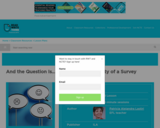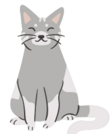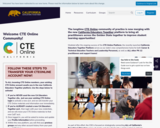
Series of videos on Anatomy and Physiology created by the team at Crash Course
- Subject:
- Science
- Material Type:
- Lesson
- Provider:
- Crashcourse
- Date Added:
- 05/21/2018

Series of videos on Anatomy and Physiology created by the team at Crash Course

Students use the model of the infamous Bill and Ted from the feature film "Bill and Ted's Excellent Adventure" to "go back in time" to learn about deities in the ancient world. After researching, studying, and viewing reproductions of artworks that depict gods and goddesses, students transport their chosen deities to the modern world as characters they write about in a mock television talk-show script, which they enact for the class.

With wisdom and wit, Anupam Mishra talks about the amazing feats of engineering built centuries ago by the people of India's Golden Desert to harvest water. These structures are still used today -- and are often superior to modern water megaprojects. A quiz, thought provoking question, and links for further study are provided to create a lesson around the 17-minute video. Educators may use the platform to easily "Flip" or create their own lesson for use with their students of any age or level.

Students review the basic conventions for using quotations from literature or references from a research project, focusing on accurate punctuation and page layout, then apply the conventions to their texts.

Students will identify nouns, verbs, and adjectives visible in two paintings depicting a stormy and calm landscape, respectively. They will write a narrative inspired by the paintings, paying attention to transitional phrases and sensory details. Students will use color and line to create their own calm or stormy landscape.

Students prepare for the associated activity in which they investigate acceleration by collecting acceleration vs. time data using the accelerometer of a sliding Android device. Based on the experimental set-up for the activity, students form hypotheses about the acceleration of the device. Students will investigate how the force on the device changes according to Newton's Second Law. Different types of acceleration, including average, instantaneous and constant acceleration, are introduced. Acceleration and force is described mathematically and in terms of processes and applications.

In this lesson, students learn to ask the right questions about the validity of surveys.

Theres no question that students will be able to compose good survey questions by the end of this lesson.

Students will learn about the Transit of Venus through reading a NASA press release and viewing a NASA eClips video that describes several ways to observe transits. Then students will study angular measurement by learning about parallax and how astronomers use this geometric effect to determine the distance to Venus during a Transit of Venus. This activity is part of the Space Math multimedia modules that integrate NASA press releases, NASA archival video, and mathematics problems targeted at specific math standards commonly encountered in middle school textbooks. The modules cover specific math topics at multiple levels of difficulty with real-world data and use the 5E instructional sequence.

Developed for second grade. Students will:; Name the characteristics of animal groups. Classify the major animal groups such as: mammals, birds, reptiles, amphibians, fish, and insects. Identify the elements of specific habitats that each animal needs in order to survive. Wonder, plan, investigate, reflect, share and act through the scientific method.Biology In Elementary Schools is a Saint Michael's College student project. The teaching ideas on this page have been found, refined, and developed by students in a college-level course on the teaching of biology at the elementary level. Unless otherwise noted, the lesson plans have been tried at least once by students from our partner schools. This wiki has been established to share ideas about teaching biology in elementary schools. The motivation behind the creation of this page is twofold: 1. to provide an outlet for the teaching ideas of a group of college educators participating in a workshop-style course; 2. to provide a space where anyone else interested in this topic can place their ideas.

In the Animal Science course, students study large, small, and specialty animals. Students explore the necessary elements--such as diet, genetics, habitat, and behavior--to create humane, ecologically and economically sustainable animal production systems.

Students listen to fiction and nonfiction read-alouds and explore selected Websites to identify factual information about animals. This lesson focuses on ants, but can be adapted to any animal.

Learn about the structure and function of living organisms by drawing an imaginary animal in the Take the Stage game show, ANIMAL SURVIVAL! Viewers become contestants on a game show and are challenged to draw an imaginary animal that could live and survive in either the desert, ocean, or the arctic tundra. When drawing the imaginary animal, the contestants write out two distinct structures and a function for each of the structures that help it survive. Learning Objective: Compare the structures and functions of different species that help them live and survive in a specific environment.

Students will learn about the sources of different foods by differentiating between foods originating from plants and foods originating from animals.

This thematic unit from Comox Valley Schools (SD71) in B.C. is aimed at Grade 6 Core French students, but is suitable for younger grades and would be easily adaptable for older ones. It is focused on oral practice and participation and would also be useful in French Immersion classes!Content Authors: Comox Valley Schools, Learn71, Beth Peddle

Students are introduced to the classification of animals and animal interactions. Students also learn why engineers need to know about animals and how they use that knowledge to design technologies that help other animals and/or humans. This lesson is part of a series of six lessons in which students use their growing understanding of various environments and the engineering design process, to design and create their own model biodome ecosystems.

Following the traditional form of the haiku, students publish their own haikus using Animoto, an online web tool that creates slideshows that blend text and music.

This instructional program prepares students to use artistic and technological foundations to create animated presentations for industry and entertainment. Students will develop basic drawing and design skills, learn the fundamentals and physics movement, the concept of communication to a given audience, and techniques for self-expression through a variety of animated formats. They will explore the careers and requisite skills required by animators in both entertainment and the business world.

Nine-year old Anthony is proud of his history, culture, and family tradition of Mexican rodeo-style roping and riding. He also enjoys various aspects of his modern life such as school, basketball, friendships, swimming, and exploring.

Antimatter, the charge reversed equivalent of matter, has captured the imaginations of science fiction fans for years as a perfectly efficient form of energy. While normal matter consists of atoms with negatively charged electrons orbiting positively charged nuclei, antimatter consists of positively charged positrons orbiting negatively charged anti-nuclei. When antimatter and matter meet, both substances are annihilated, creating massive amounts of energy. Instances in which antimatter is portrayed in science fiction stories (such as Star Trek) are examined, including their purposes (fuel source, weapons, alternate universes) and properties. Students compare and contrast matter and antimatter, learn how antimatter can be used as a form of energy, and consider potential engineering applications for antimatter.